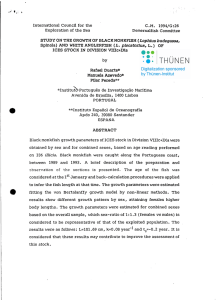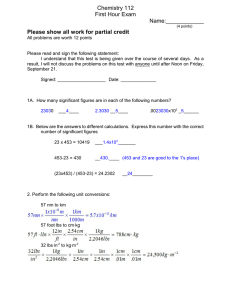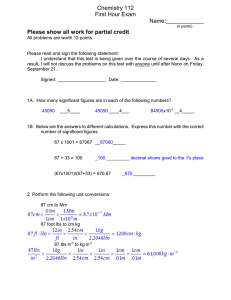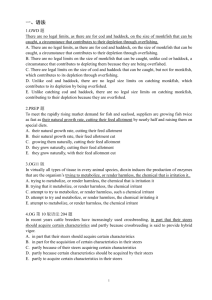•
advertisement
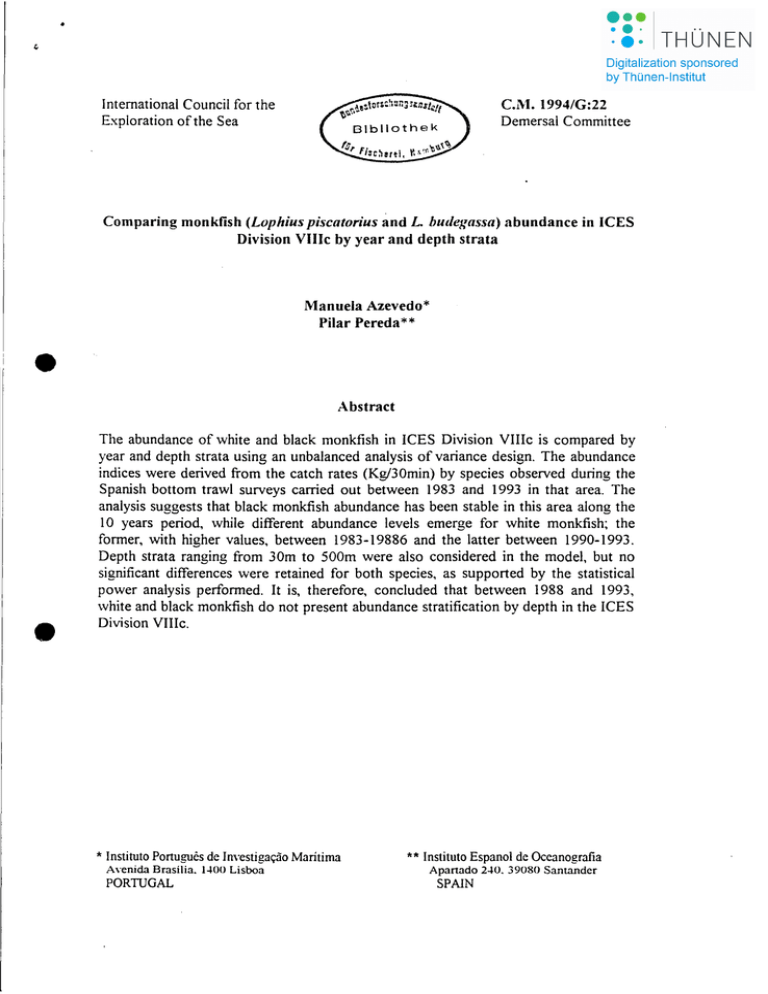
•
International Council for the
Exploration ofthe Sea
C.M. 1994/G:22
Demersal Committee
Comparing monkfish (Lophius piscatorius and L. huclegassa) abundance in ICES
Division VllIc by year and depth strata
Manuela Azevedo*
Pilar Pereda**
•
•
Abstract
The abundance of white and black monkfish in ICES Division VIIIc is compared by
year and depth strata using an unbalanced analysis of variance design. The abundance
indices were derived from the catch rates (Kg/30min) by species observed during the
Spanish bottom trawl surveys carried out between 1983 and 1993 in that area. The
analysis suggests that black monkfish abundance has been stable in this area along the
10 years period, while different abundance levels emerge for white monkfish; the
former, with higher values, between 1983-19886 and the latter between 1990-1993.
Depth strata ranging from 30m to 500m were also considered in the model, but no
significant differences were retained for both species, as supported by the statistical
power analysis performed. It is, therefore, concluded that between 1988 and 1993,
white and black monkfish do not present abundance stratification by depth in the ICES
Division VIIIc.
* Instituto Portugues de Investigac;ao Maritima
Ayenida Brasilia.
PORTUGAL
I~OO
Lisboa
** Instituto Espanol de Oceanografia
Apanado
SPAIN
2~O.
39080 Santander
•
Introduction
The species of monkfish (Lophills spp.) are widely distributed in the Atlantic. Both
species are caught as a whole in the Southem stock (lCES Divisions VIIIc and IXa) by
trawl and fixed nets tisheries.
Since 1980 the Spanish Institute of Oceanography carried out bottom trawl surveys
having among its objectives the estimation of the abundance indices of the most
important commercial species. Sanchez et al. (1991) analyze the evolution of the
results of these surveys. The bathymetric distribution of the species of the Cantabrian
Sea has been studied by Sanchez (1993) indicating that black monkfish (L. blldegassa)
appears between 75m and 400m depth, preferenciaIly to the 200m depth while white
monkfish (L. piscatorills) is distributed between 50m and 300m depth, with preference
for the depth range 75-175m.
During the ICES Southem Shelf Demersal Stocks Working Group meeting (lCES,
1994) monkfish abundance index, obtained from Spanish and from Portuguese surveys,
were plotted in order to visuaIly analyze the abundance trend along the available time
senes.
This paper is presented with the aim of improving the knowledge about monkfish
spatial distribution, as weIl as its abundance trend between 1983 and 1993 in the
Cantabrian Sea (lCES Division VIIIc).
~1aterial
A data series of white and black monkfish catch rates, expressed in Kg/30min., was
obtained between 1983 and 1993 during the Spanish bottom trawl surveys, which
foIlowed a stratified random design (Sanchez er al., 1991); the year 1987 was not
covered. The sampled area ranges from the mouth of Bidasoa river and the Cape
Finisterre, included in ICES Division VlIIc and the depth strata ranges from 30m to
500m, iesulting in a total of 656 sampled units. The observed mean catch rates by
species are presented in Table 1.
2
•
•
Table 1 - Monkfish mean catch rates (Kg/30min) in leES Division VlIIc, by species.
observed during the Spanish bottom trawl surveys carried out between 1983 and 1993.
Year
White monkfish
Black monkfish
Depth (m)
Depth (m)
JO-IOO
•
101-200
201-50!)
JO-J()O
101-200
201-500
1983
1.01
3.29
5.8~
1.38
0.98
0.75
1984
2.77
2.65
7.00
0.73
0.74
OA9
1985
0.32
1.79
3.34
0.90
OA8
0.88
1986
1.85
5.19
4.24
O. OS
1.85
1.66
1988
2.70
3.81
7.31
2.06
3.34
2.03
1989
1.01
0.64
OAI
1.08
0.65
0.35
1990
1.62
1.73
2.18
1.37
J._J
0.76
1991
0.76
1.70
0.64
1.59
1.78
n,85
1992
0.53
1.37
1.49
1.00
2.17
0.73
1993
n.u
1.39
2.21
1.31
1.13
1.84
. .,.,
Methods
The continuous random variable, catch rate (Kg/30min), assumed to be obtained
randornly from normal populations, with equal variances is analyzed by year (19831993), by depth strata (30m-500rn) and by species. It is also assumed that the effects
of the factors levels are additive. So, the comparisons were performed using an
analysis of variance. Since the design is unbalanced, i.e, nonorthogonaL two
•
approaches for computing the surn of squares can be applied: the unweighted mean
approach or the analysis of unique sources, following the regression approach to the
analysis of variance (Netter, et. al., 1990). The former was used. As there still may be
a slight bias associated with the tests performed this way (Netter, et. al., 1990;
Lindman, 1992) than to compensate for any positive bias, associated with the omnibus
test, a more stringent significance' level was used (Keppel,
1991) for the
experimentwise eITor rate, being ae~"p set equal to 0.03. As a consequence, the
familywise eITor rate was set equal to afw=0.03/c, where c stands for the number of F
tests performed.
The requirements of normality, homocedasticity, stated previously and also
uncorrelation between means and standard deviations, were checked. The data
3
•
deviated from these requirements, both for white and black monkfish raw data and
therefore, data transtormation was applied.
The effects of factor Year (l0 levels: 1983-1986, 1988-1993), factor Depth (3 levels:
30-100m, 101-200m, 201-500m) and ofthe interaction Year*Depth, in the abundance
of \vhite and black monkfish were assessed. Post hoc comparisons \vere performed
whenever a significant effect was detected. Power analysis was also conducted in order
to evaluate the probability of having committed a type II eITor.
Results
Tramiformation ofraw clata
White monkfish raw data was transformed to (Kg/30min)U.25 and black monkfish data
to (Kg/30min)U.15. The different form ofthe random variables resulted in uncorrelated
means
l'S
standard deviations for both species (the critical r value at 5% significance
•
level was considered). Homogeneity hypothesis, tested with Bartlett test and compared
to the 5% significance level, was not rejected for black monkfish (p=0.988), although
rejected for white monkfish (p«0.05). Normality assumption was checked on withincell residuals for both species and considered not to be violated.
Unbalancetl analysis ofvariance
Table 2 presents the outputs ofthe omnibus test performed for white monkfish. The p
values were compared to arw= 0.01, as previously explained. Only differences between
years are outlined. This feature is also infeITed for black monkfish (Table 3).
Table 2 - Analysis of variance outputs for white monkfish (df - degrees of freedom,
.MS - mean square).
Source of
df
MS
F
I) ,'alue
Year
I)
1.362
~.~66
0.000
Deplh
2
0.273
0.895
0..f09
Year*Depth
18
0.3~~
1.129
0.319
errar
626
0.305
variation
•
Table 3 - Analysis of variance outputs far black monkfish (df - degrees of freedom,
MS - mean square).
<Jf
MS
F
Jl "alue
Year
9
(1.7-l1
2.873
0.002
Depth
2
0.169
0.657
0.519
Year*Depth
18
0.330
1.280
0.19-l
error
626
0.258
Source of
yariation
•
Post hoc comparisons
Pairwise comparisons were performed taking into account the nonorthogonal design
used and controlling the ufw eITor rate. The summary of the results is presented in
Table 4 for white monkfish, which should be read as pairs (1983, 1991), (1983, 1993),
(1984, 1989), (1984, 1991) and so on.
Table 4 - Summary of the results of the post hoc comparisons performed far white
monkfish.
Year level
Signiticant pairn'ise differences
(c~n,=O.OI)
•
1983
1991. 1993
198-l
1989. 1991. 1992. 1993
1986
1991. 1992. 1993
1988
1991
It is stressed the significant differences in white monkfish abundance between 1983,
1984 and 1986 and the most recent years (1991, 1992 and 1993), with the exception
ofthe pair (1983, 1992). Year 1984 also differ from 1989 and 1988 from 1991. It is
also stressed that most recent years do not differ between each other. It is observed
that alang the analyzed period the lowest monkfish abundance occuITed between 1991
5
and 1993; backtransforming the random variable to the original scale. Kg/30min.. the
mean catch rate of those years range from 0.12 to 0.37 Kg/30min., when in 1983,
1984 and 1986 it was observed a mean abundance ranging from 1.62 to 1.78
Kg/30min.
Table 5 presents the results far black monkfish. They show that significant differences
occur between 1988 and the previous years (period 1983-1986) and also between
1992. It is therefore concJuded that, with the exception of 1988, when the highest
mean abundance was observed, no abundance differences in black monkfish have
occurred along the analyzed period.
Table 5 - Summary ofthe results ofthe post hoc comparisons performed for black
monkfish.
Year lewl
Si~nificant
paim"ise differences
•
(af\\=().Ol)
1988
1983.
198~.
1985. 1986. 1992
Power analysis
Power analysis was performed for the main effect Depth. It was considered that if
medium to large effects were really present, than the null hypothesis tested is a true
statement about the population sampled. The results, under these conditions, show that
the probability of having committed a type II eITor is very low for both species,
resulting in power levels beyond 99%.
Conclusions
It is concluded that black monkfish abundance by year has been stable, in leES Div.
VlIIc, along the 10 years period (1983-1993). The year 1988 is an exception, since it
was observed a higher mean abundance. A similar analysis, carried out for black
monkfish in leES Division IXa (Portuguese waters - south and southwest coast)
between 1990 and 1992 and between 100-400m depth strata (Azevedo, 1994), shows
an abundance decrease between those years in the southwest coast (37°00'N -
6
•
38°40'N), although this feature was not infered to the south zone (7°15'W - 9°00'W).
With respect to depth strata, the author points out that black monkfish abundance
levels differ between 100-200m and 300-400m depth strata, in the south coast.
Therefore, when comparing these results it seems that black monkfish present different
distribution patterns and abundance trends in ICES Division VIIIc and IXa. In the
fonner area the abundance of this species has been relatively stable between 1983 and
1993 and shows no abundance stratification by depth, while in the latter area the
analysis performed (Azevedo, 1994) suggests that black monkfish occur preferentially
in the continental shelf in the Portuguese south zone and that the species abundance
decreased in most recent years (1990-1992), at least in the Portuguese southwest zone.
The abundance of white monkfish in ICES Division VIIIc was higher between 1983
•
and 1986 (exception to the year 1985) and after 1988 has decreased. No significant
differences between the depth strata analyzed (30m-500m) were retained, suggesting
that the abundance levels of this species in the this area do not differ between the
continental shelf and the shelf edge.
References
Azevedo, M., 1994. A statistical analysis of black monkfish catch rates in ICES
Division IXa. 11 pp. (unpublished).
ICES, 1994. Report of the Working Group on the Assessment of the Southern Shelf
Demersal Stocks. ICES, C.A!. 199-1iAssess: 3.
•
Keppel, G., 1991. Design and ana{vsis. A researcher's handhook. Prentice Hall, N.J.
(3rd. ed.).
Lindman, H.R., 1992. Analysis
N.Y.
0/ mriance in experimell1al design.
Springer-Verlag,
Netter, 1.; Wasserman, \V.; Kutner, M. H., 1990. Applied linear statistical model,>.
Regression. ana(vsis ofl'ariance and experimell1al designs. IRWIN, Boston (3rd. ed.).
Sanchez, F.; Pereiro, F.J.; Rodriguez-l\1arin, E., 1991. Abundance and distribution of
the main commercial fish on the northern coast of Spain (ICES Division VlIIc and
IXa) from bottom trawl surveys. ICES, C.A/. 1991G:53.
Sanchez, F., 1993. Las comunidades de peces de la plataforma delCantäbrico. Tesis
doctoral. Pub!. Espec. l11st. Esp.Oceallogr., 13.
7

